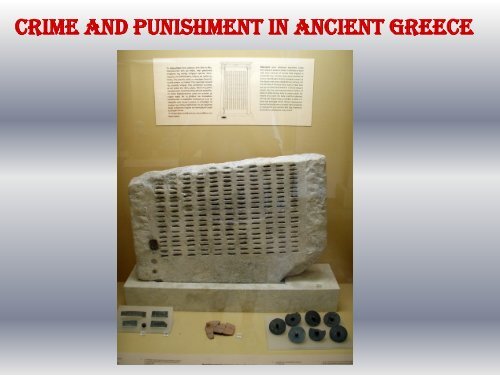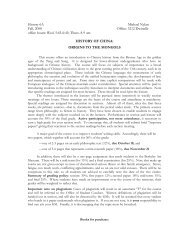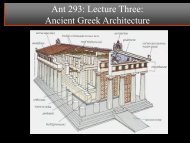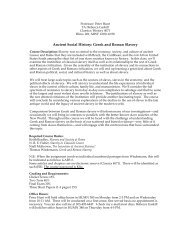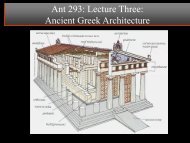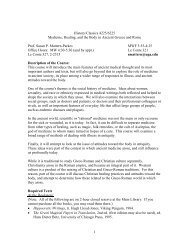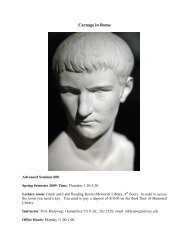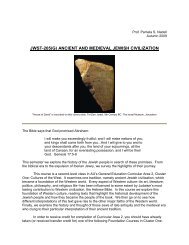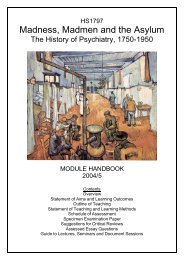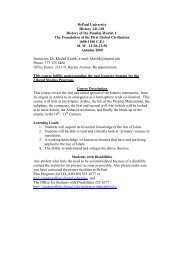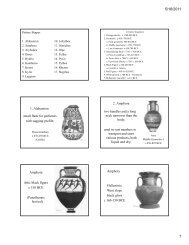Crime And Punishment In Ancient Greece
Crime And Punishment In Ancient Greece
Crime And Punishment In Ancient Greece
- No tags were found...
You also want an ePaper? Increase the reach of your titles
YUMPU automatically turns print PDFs into web optimized ePapers that Google loves.
CRIME AND PUNISHMENT IN ANCIENT GREECE
LECTURE OUTLINE: OF DRACONIAN MEASURES AND THE WISDOM<br />
OF SOLON – CRIME AND PUNISHMENT IN ANCIENT GREECE<br />
PRELUDE: ORESTES AND GREEK JUSTICE<br />
A. INTRODUCTION<br />
B. EARLY GREEK LAW<br />
1. The Homeric Age<br />
2. Classical Crete <strong>And</strong> Sparta<br />
C. CRIME, PUNISHMENT AND THE RULE OF LAW IN CLASSICAL ATHENS<br />
1. The Reforms Of Draco <strong>And</strong> Solon<br />
2. Procedure<br />
a) The Basics; b) Preliminaries; c) The Trial; d) The Jury; e) The Verdict<br />
3. Types Of Offences<br />
a) Homicide; b) Property Offenses; c) Offenses Against The State; d)<br />
Religious Offenses; e) Assault, Abuse, Slander <strong>And</strong> Hybris<br />
4. Women <strong>And</strong> The Law<br />
5. Types Of <strong>Punishment</strong>s
Antigone accompanies her father Oedipus into exile
A bust of<br />
Sophocles
A scene from The Clouds (Aristophanes)
A representation of the sacrifice of Iphigenia from Pompeii
Clytemnestra and Aegisthus murder King Agamemnon
John Collier’s<br />
“Clytemnestra”<br />
(1900)
Orestes kills Aegisthus
Orestes hounded by the Furies
Orestes seeks ritual purification and advice at Delphi
The Areopagus Council Hill in Athens:<br />
Scene of the mythic trial of Orestes and later of the Athenian Homicide Court
The trial of Orestes on the Areopagus
LECTURE OUTLINE<br />
PRELUDE: ORESTES AND GREEK JUSTICE<br />
A. INTRODUCTION<br />
B. EARLY GREEK LAW<br />
1. The Homeric Age<br />
2. Classical Crete <strong>And</strong> Sparta
The 5 th -century BCE Gortyn Law Code (Crete) is located by the Odeion
The main Gortyn inscription was re-discovered in 1884.
Lycurgus: The historical ()/ mythical () law-giver of Sparta
Draco was an archon who introduced new Athenian laws in 621 BCE.
Solon introduced major legal and social reforms in 594/593 BCE.<br />
He would remain an iconic figure, idealized as an all-wise judge.
The “Laws of Solon” were displayed in the Royal Stoa in the Agora<br />
well into the Classical Age.
LECTURE OUTLINE<br />
C. CRIME, PUNISHMENT AND THE RULE OF LAW IN CLASSICAL<br />
ATHENS<br />
1. The Reforms Of Draco <strong>And</strong> Solon<br />
2. Procedure<br />
a) The Basics<br />
b) Preliminaries<br />
c) The Trial<br />
d) The Jury<br />
e) The Verdict
THE BASICS<br />
Athenian justice was no less purposefully democratic than its politics.<br />
The courts were in session about 200 days a year.<br />
One of Solon’s innovations was to allow anyone to initiate proceedings<br />
in cases where an offense was regarded as affecting the community<br />
as a whole. This established a distinction between a private case<br />
(dike idia), brought by a prosecutor who complained that he had<br />
suffered some wrong personally, and a public case (dike demosia),<br />
brought by anyone on behalf of the general public.<br />
With few exceptions, all legal actions were brought by an individual.<br />
To a large extent, anyone pursuing a wrong, against himself or<br />
society, was left to do the work which in modern states is usually<br />
done by official bodies.<br />
Very limited assistance from The Eleven and/or from the Scythian<br />
Slaves but . . .
ATHENIAN TRIALS<br />
Trials consisted of opening argument, speeches made by orators for<br />
both parties, the reading of pertinent laws and depositions, the<br />
testimony of male witnesses, and closing arguments.<br />
The jury members were entirely responsible for deciding questions<br />
both of law and of fact.<br />
First the prosecutor and then the defendant made a speech; in some<br />
cases each was permitted to speak twice.<br />
Each was allowed the same length of time for speaking, measured by a<br />
water-clock (klepsydra).<br />
Each litigant was expected to speak for himself; he was not allowed to<br />
pay for a lawyer to speak on his behalf.
A<br />
surviving<br />
klepsydra
EVIDENCE<br />
The Athenians rarely employed forensic evidence in court and the<br />
main work of an investigation was therefore the task of gathering<br />
witnesses.<br />
By the fourth century BCE, witnesses merely presented themselves in<br />
court to confirm a written deposition drafted by the litigant for<br />
whom they appeared.<br />
A prosecutor could summon a man to appear as a witness and<br />
prosecute him for failure to testify (lipomartyrion).<br />
There was no opportunity to cross-examine a witness.<br />
For evidence of a slave to be used formally it court, it had to be<br />
extracted under torture (basanos, literally “test”).
SYCOPHANTS<br />
To encourage public prosecutions, the state in some public cases<br />
gave a prosecutor a proportion of the fine or property confiscated<br />
from the offender if he won his case.<br />
Men who made a habit of prosecuting for their own dishonorable<br />
purposes became known as sycophants.<br />
To discourage unjustified prosecution, a law was introduced imposing<br />
a penalty on a prosecutor in most kinds of public cases if he either<br />
obtained less than one-fifth of the jury’s votes or abandoned the<br />
case before the trial.<br />
The penalty was a fine of 1,000 drachmas with (at least in some cases)<br />
partial disfranchisement in addition.<br />
It was also possible to prosecute a man for being a sycophant.
ATHENIAN TRIAL BY JURY<br />
Well-developed by 5 th -century BCE. Emerged from reforms of Solon<br />
and right to appeal an archon’s verdict to a citizen body called the<br />
eliaia.<br />
Juries selected by lot from the entire citizen body.<br />
List of 6,000 potential jurors for the year was drawn up.<br />
Sizes of jury ranged from 200 to +1000 men.<br />
Each juror paid three obols a day.
THE VERDICT<br />
At the end of the litigants’ speeches, the jury voted at once, without<br />
further advice or deliberation.<br />
The majority decided the verdict.<br />
The method of voting was by placing pebbles, or later bronze disks, in<br />
urns for conviction or acquittal; various devices enabled a juror to<br />
conceal which way he voted.<br />
For some offences the penalty was laid down by law, but in other<br />
cases the penalty of the amount of damages had to be decided by<br />
the jury.<br />
<strong>In</strong> such cases, when the guilty verdict had been given against the<br />
defendant, the prosecutor proposed a penalty and the defendant<br />
proposed another.<br />
The jury voted again to decide between them.
Jury voting disks from the 4 th century BCE
HOMICIDE<br />
Homicide was a special area of law with its own distinctive procedures.<br />
There was, for example, a special homicide oath – the diomosia – in<br />
which the litigants and witnesses alike participated.<br />
Homicide was a private matter, with the victims’ relatives having not<br />
just a familial but indeed a sacred responsibility to punish the killer.<br />
Purification was required because killing was believed to cause<br />
pollution (miasma).<br />
The accused was ordered to stay away from certain places after the<br />
proceedings had been initiated but before the trial itself.<br />
All trials for homicide were held in the open air, so that all those<br />
present might avoid the pollution of going under the same roof as a<br />
killer.
THE HOMICIDE COURTS<br />
One of the most striking features of homicide law was the range of<br />
available courts.<br />
There was a set of homicide courts, the most famous of which was the<br />
Areopagus Council, manned by former archons.<br />
Those trials that did not qualify for the Areopagus were judged by the<br />
ephetai at a variety of courts in and around Athens.
The Council of the Areopagus tried only cases in which someone was<br />
accused of killing an Athenian citizen intentionally with his own hand.
The Delphinion: Tried cases in which the accused argued<br />
that the killing was lawful.
The Palladion: Tried cases in which the person was accused<br />
of unintentional homicide or homicide of an alien or a slave.
OTHER HOMICIDE COURTS<br />
If someone already exiled for unintentional homicide was accused of<br />
committing another homicide intentionally, he could not enter<br />
Attica for trial, but was allowed to make his defence from a boat<br />
offshore at a place called Phreatto, while the ephetai sat on the<br />
beach.<br />
Homicides alleged to have been committed by an unknown person, or<br />
by an animal or inanimate object, were tried at the Prytaneion, a<br />
building on the northern side of the Acropolis.<br />
An animal found guilty of homicide was presumably put to death or<br />
driven out of Attica.<br />
An inanimate object, such as a stone or a tree which had fallen on a<br />
person and killed him, was cast beyond the frontiers of Attica.
PROCEDURE IN HOMICIDE CASES<br />
Three pre-trials (prodikasiai) were held in three separate months for<br />
homicide cases, with the trial itself in the fourth month. We do not<br />
know much about the details of these pre-trials.<br />
Each side made two speeches.<br />
At the end of his first speech, the defendant was allowed to go into<br />
exile rather than face the possibility of execution.<br />
The penalty for intentional homicide was death and confiscation of<br />
property.<br />
For unintentional homicide the penalty was exile – anyone who found<br />
him back in Attica could kill him with impunity.<br />
Exile could be ended with a pardon (aidesis) from the deceased<br />
person’s family.
PROPERTY OFFENSES<br />
A person who suspected another of having stolen something of his<br />
might demand admission to his house to search it.<br />
Summary executions by members of The Eleven could be used against<br />
kakourgoi (“wrongdoers”) caught red-handed.<br />
Those who qualified here included kidnappers, clothes stealers,<br />
highwaymen, house burglars, temple robbers and cutpurses.<br />
Anyone catching such a thief could arrest him and take him to The<br />
Eleven.
OFFENSES AGAINST THE STATE<br />
Athenian democracy was deeply suspicious of public officials,<br />
and there were procedures in place to try to ensure that<br />
these figures did not overstep appropriate boundaries.<br />
At the end of one’s period in office, every public official had to<br />
formally render account for his services in a process known<br />
as euthunai.<br />
By the fourth century BCE, this seems to have been replaced by<br />
the possibility of eisangelia, roughly comparable to our idea<br />
of impeachment.<br />
Usually, eisangelia was brought directly before the full<br />
assembly.
SPECIAL PROVISIONS<br />
<strong>In</strong> an effort to encourage such actions, the prosecutor who<br />
failed to obtain 20% of the votes cast was not punished, as<br />
was the case in other public proceedings.<br />
Anyone who suspected treason could go directly to the<br />
Assembly or Boule council to report their suspicions rather<br />
than go through any preliminaries with a magistrate.<br />
A slave who participated in such informing (menyis) was<br />
normally given his freedom, though this may not have been a<br />
legal requirement.
The Arginousai Generals were charged for abandoning the<br />
survivors of the Battle of Arginousai in 406 BCE.
RELIGIOUS OFFENSES<br />
The law stated that at certain festivals no one might seize money or<br />
other property from another person, even if it was something to<br />
which he was otherwise legally entitled.<br />
The procedure of graphe could be used for any impiety (asebiia) on<br />
any occasion.<br />
A number of individuals were prosecuted in the second half of the fifth<br />
century BCE for atheism.
ASSAULT, ABUSE, SLANDER AND HYBRIS<br />
It was an offense to strike a blow at another person, and an ordinary<br />
private case of battery (dike aikeias) could be brought for it. If two<br />
men had a fight in which each hit the other, only the one who struck<br />
the first blow was guilty.<br />
Athenians had several laws prohibiting slander and abusive language.<br />
Another way of dealing with assault or abuse was available if the<br />
offense was an act of hybris. Modern writers often translate it as<br />
“arrogance,” but that does not represent the range of the Greek<br />
word adequately.<br />
The offense of hybris perhaps offers a window into the ancient Greek<br />
understanding of the meaning of male citizenship.
ATHENIAN WOMEN AND CRIME<br />
Is it a coincidence that the society that bequeathed to us democracy<br />
was also arguably the most patriarchal in the ancient world<br />
Even aristocratic women in Classical Athens had no legal capacity of<br />
their own, but were always under the kyreia or guardianship of a<br />
man.<br />
Neither women nor children could appear in court as witnesses.<br />
If a male prosecutor wished to introduce the testimony of a woman<br />
into court, he had to use a process called “oath challenge.”<br />
Women were not permitted to serve on juries.
FEMALE VICTIMS<br />
The rape of a free Athenian woman was punished by a fine of 100<br />
drachmas.<br />
The penalty for a man who seduced or committed adultery with a free<br />
woman was death.<br />
A man who merely stepped over the threshold of the house of another<br />
without permission of the owner had committed the crime of<br />
outrage.<br />
Rape was legally a crime against a woman’s father or husband.<br />
When a married woman was raped, her husband had a legal obligation<br />
to divorce her, under penalty of losing his rights of citizenship.
FEMALE OFFENDERS<br />
Women accused of crimes could not defend themselves in court, but<br />
had to rely on a male relative to represent and defend them.<br />
If the penalty for a man who committed adultery with the wife of a<br />
citizen was death, the penalty for the woman was a miserable life.<br />
Legally a divorced adultress could remarry, but in practice this was<br />
unlikely because of her public shame.<br />
Abortion was an offense when a woman induced or procured it without<br />
the knowledge and consent of her husband or kyrios.<br />
There were certain crimes that only alien women and men could<br />
commit: failure to have a patron; failure to pay the alien tax;<br />
simulation of citizenship; and marriage with a citizen.<br />
The penalty for marriage with a citizen was being sold into slavery.
The famous 4 th -<br />
century BCE case of<br />
Neaira involved the<br />
accusation that she<br />
had violated the law<br />
prohibiting an alien<br />
woman or man living<br />
as if in marriage with<br />
an Athenian citizen.
A man about to<br />
solicit sex from<br />
a young male<br />
prostitute
PROSTITION AND CITIZENSHIP IN CLASSICAL ATHENS<br />
Neither female nor male prostitution was illegal.<br />
Procuring a free woman or man for seduction was, however, punishable by<br />
death.<br />
Any guardian who prostituted a boy in his charge or any person who<br />
enticed a youth of citizen status into prostitution by offering him money<br />
for sexual favours faced grave penalties.<br />
An Athenian male of citizen status who had hired out his body to anyone<br />
for sexual use forfeited his citizen rights.<br />
Once an Athenian citizen had forfeited his citizen rights as a result of<br />
having been a prostitute, it was a capital crime to exercise those rights.<br />
The body of a citizen was considered sacrosanct.<br />
Anyone who prostituted himself threatened the coherence of democracy<br />
from within.
A male client<br />
solicits sex from<br />
a female<br />
courtesan:<br />
Prostitution<br />
seen as a proud<br />
achievement of<br />
Athenian<br />
democracy
FEMALE PROSTITUTION AND ATHENIAN DEMOCRACY<br />
Among the reforms credited to Solon was the institution of brothels staffed<br />
by slave women at a price that put them within the reach of all citizens.<br />
Commercial sex would no longer be reserved for the wealthy.<br />
There would always be a category of persons for citizens to dominate,<br />
socially and sexually.<br />
The disenfranchisement of male prostitutes and the inexpensive provision<br />
of female prostitutes can from one perspective be seen as linked to a<br />
new collective image of the citizen body as masculine and assertive,<br />
and as in control of its own pleasures.<br />
Athenian democracy was marked by a series of dualities: master and slave;<br />
dominant and submissive; active and passive; customer and prostitute;<br />
citizen and non-citizen; male and female.
PUNISHMENT<br />
<strong>In</strong> some categories of case the penalty was predetermined by statute.<br />
<strong>In</strong> others, the jury decided the penalty by a system of counterassessment.<br />
The prosecutor was personally involved to an extent not known today.<br />
There were two categories of punishment – physical and financial.<br />
Imprisonment was rarely used as a punishment.<br />
The picture we get from our sources suggests that death was by far<br />
the most common of physical penalties.
FORMS OF EXECUTION<br />
The death penalty was prescribed for men and women for intentional<br />
homicide, treason and sacrilege, and for men for adultery, seduction and<br />
malfeasance in office.<br />
Early sources speak about people being thrown into the barathon (a type of<br />
pit), but it is not clear whether this was a method of execution or a place<br />
for disposing of bodies of criminal.<br />
From the fifth century BCE onwards, the most common means of execution<br />
in Athens was the plank (tympanon), a piece of wood to which the<br />
condemned person was strapped by iron bands around the neck, wrists<br />
and ankles. The plank was raised upright and the condemned died<br />
slowly over a period of days.<br />
Some offenders convicted of capital crimes were granted the “privilege” of<br />
self-execution, perhaps by hemlock.<br />
<strong>In</strong> Classical Athens, capital punishment was frequently named as the<br />
possible penalty, yet there seem to have been relatively few actual<br />
executions. Exile for intentional homicide was permanent.
ATIMIA<br />
This was a penalty which could only be imposed on male<br />
citizens.<br />
Atimia denotes the removal of time (“honour”) – the man so<br />
punished and deprived of his honour was described as<br />
atimos.<br />
The rights lost by the atimos included the right to appear in<br />
court as a litigant or witness, and the right to speak or vote<br />
in the assembly.<br />
The situation of atimoi may have been so intolerable that many<br />
preferred to move into exile.<br />
This penalty was typically life-long but not usually hereditary.
OTHER STATUS DISTINCTIONS WITH PUNISHMENTS<br />
Enslavement was a penalty imposed on an alien who resided in Athens<br />
without being registered as a metic or paying the metics’ tax.<br />
The male citizen could legitimately act outside of institutional channels<br />
to do almost anything to his own slaves.<br />
A citizen could also beat any slave caught stealing, even if the slave<br />
belonged to someone else.<br />
The male citizen had a similarly far-ranging power over the female<br />
members of his household and was expected to punish the women<br />
in his household when necessary.<br />
Male citizens who wished to punish fellow male citizens needed to<br />
proceed through the court system except in those instances in<br />
which justiable homicide was an acceptable response.
A comic<br />
respresentation<br />
of a master (on<br />
the right) with<br />
his slave (4 th c.<br />
BCE)


